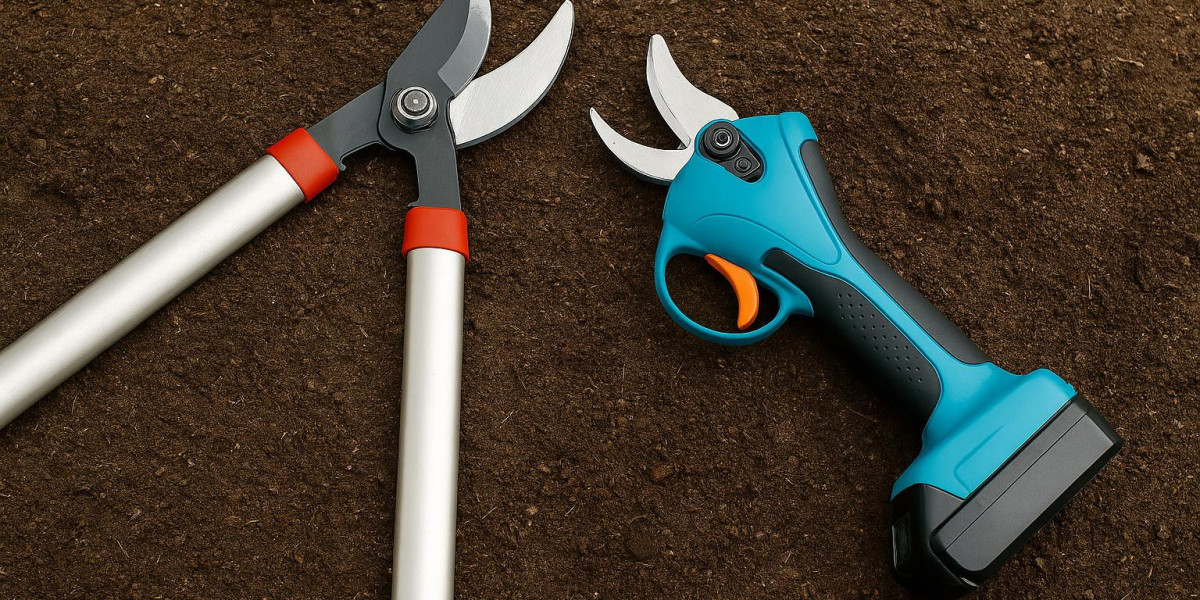If you’ve spent more than a season in the garden, you’ve likely faced a pruning job that pushed your tools to the limit. Maybe the stems were too thick for handheld pruners, or maybe the job was just too long to do manually without wrist pain. That’s when most gardeners hit a crossroads: loppers or electric pruners?
Both tools serve the same goal—cutting through branches—but their performance, cost, maintenance, and user experience are vastly different. Choosing between them isn’t about which tool looks cooler or costs more. It’s about how, where, and why you work in your garden.
From small backyard maintenance to managing a full orchard, let’s break down the facts and help you decide where to invest.
Tool Basics: What Are Loppers and Electric Pruners?
Loppers are large manual cutting tools with long handles, designed to cut branches up to 2 inches thick. They operate on basic physics—longer handles mean more leverage, so you can make powerful cuts using your own strength. Typically, loppers come in two blade types: bypass, which cuts like scissors and is ideal for live wood, and anvil, which crushes dead branches with a single strike.
Electric pruners, also called cordless or battery-powered pruners, are more high-tech. They use a motorized blade, often triggered by a soft-touch button, to deliver fast, clean cuts through stems and branches. While most electric pruners top out around 1.5 inches in cutting capacity, they offer serious speed and comfort.
These tools are designed with built-in safety locks, ergonomic grips, and in higher-end models, even adjustable blade openings.
What Really Matters: Cutting Power vs. Cutting Efficiency
This is the core difference. Loppers give you brute force and full control. You feel every branch. You decide the angle. You’re the power source.
Electric pruners, on the other hand, automate the effort. You push a button, and the blade does the work. They’re a godsend for people who prune often, have arthritis, or need to complete repetitive cuts quickly.
If you often trim dense shrubs, overgrown vines, or fruit trees, the question isn’t whether you can do it with loppers—it’s whether you want to.
This becomes even more critical when you’re upgrading your entire set of garden tools. Gardeners focused on efficiency often begin their overhaul with long-handle cutters and precision tools. If that’s you, it’s worth exploring when to Buy the Best Loppers for core pruning tasks, especially if you value silence, control, and lower long-term costs.
Garden Size and Frequency Change the Equation
Small gardens don’t require high-tech gear. If you're just tidying up rose bushes or shaping a hedge once a month, loppers are likely all you need. They're easy to store, ready on-demand, and offer solid performance for light to medium jobs.
But if your garden stretches across a quarter acre or more, or includes 20+ shrubs, trees, or vines that need regular maintenance, electric pruners start making sense. In fact, recent data from Garden Research shows that electric pruner adoption has increased 33% in large home gardens over the last two years—largely due to time savings and hand fatigue reduction.
For professionals and aging gardeners, the investment in an electric model pays off fast.
The Physical Factor: Comfort, Weight, and Strain
Loppers require strength in the upper body. You're pulling, pushing, and frequently reaching up. This can lead to weariness over time, particularly if your grip strength has decreased.
Most people are surprised to learn that electric pruners weigh only two to three pounds. Holsters for climbing or vine work are even included with some models. They greatly lower the risk of repetitive strain injuries, which are particularly prevalent in elderly gardeners or those with carpal tunnel syndrome, because they don't require manual squeezing.
Nevertheless, the batteries that power electric pruners need to be charged, cared for, and eventually changed. It could be a drawback if you don't like handling equipment.
"Good tools don’t just get the job done—they make you want to do it again tomorrow."
Safety Features and Concerns
Electric pruners can be dangerous due to their power. Modern models have automated blade retraction systems and safety controls, but accidents can still happen, especially if fingers get too close to the cutting region.
Because they must use two hands and more deliberate power, lopers are safer in comparison. The chance of an accidental snip is decreased when you must close the blades with your complete body.
In both cases, gloves, proper form, and focus are essential. When conducting operations at heights or in limited places, always consider position and visibility before making a cut.
Durability and Maintenance
Loppers have a long lifespan. Completed! Store them indoors, clean the blades, and oil the joints. Some gardeners still use hand-me-down loppers from the 1980s, with only a few blade replacements.
Electric pruners require more maintenance despite their greater sophistication. Before replacing the battery, it needs to be charged. Blade dulling occurs more quickly at higher cutting speeds. Internal parts may degenerate after thousands of cuts.
However, more costly electric pruners come with self-lubricating blades, backup batteries, and digital maintenance tracking apps. According to a Fine Gardening study on product durability, mid-range electric pruners last five to seven years with regular use, while professional-grade models can last over ten years.
Cost vs. Value: What's the Real Investment?
Manual loppers are reasonably priced. A good pair will cost between $40 and $80. Professional models with carbon-steel blades and telescoping handles may cost as much as $120.
However, the price of electric pruners varies from $100 to $600 based on features, battery capacity, and blade sharpness. You'll need to pay more up front if you also need new blades and batteries.
However, when time savings and less physical strain are taken into account, the value equation changes. Electric pruners can really save hours for gardeners who manage vast estates or prune once a week.
However, the ease of use and durability of loppers make them a better investment if you only prune seldom or prefer the tactile sensation of hand cutting.
Extra Features to Consider
Digital screens that display the battery level, number of cuts, and blade settings are included with certain electric pruners. Other features include rotating heads for odd angles or auto-cleaning devices.
Loppers vary greatly, despite their simplicity. To increase torque without using more force, some use ratcheting devices. Others include arms that can be extended or grips that buffer impact.
Both tools can be enhanced by special features like titanium-coated blades, strengthened bolt systems, and ergonomic loop handles, but only if you chose them based on your real gardening practices rather than marketing gimmicks.
FAQs
Which tool cuts thicker branches better?
Loppers typically handle thicker wood—up to 2 inches—while electric pruners usually max out at 1.5 inches.Do electric pruners need sharpening?
Yes. Just like manual blades, electric pruner blades should be sharpened or replaced periodically for clean cuts.Are electric pruners waterproof?
No. Most models are water-resistant at best, and should be kept dry to protect the motor and battery.Can loppers replace a pruning saw?
To an extent. For anything over 2 inches thick or hardwood cuts, a pruning saw is still the best choice.Are there lightweight electric pruners for seniors?
Yes. Several brands now offer compact models with under 2.5 lb weight and arthritis-friendly grip designs.
Don't Choose a Tool—Choose a Workflow
The question "Which tool is worth your money?" isn't the only one. "What kind of gardener are you becoming?" is the question.
Loppers provide simplicity and happiness if you appreciate being near the job, the rhythm of manual cutting, and long-lasting instruments. Electric pruners are an indisputable advantage if you're pruning on a larger scale, have physical constraints, or need to cut more in less time.
It is not a matter of taking sides. Both are owned by many experienced gardeners. When they want speed, they employ electric pruners; when they want control, they use loppers. After all, the best gardens are created with equipment that are appropriate for the user's pace and goals.







